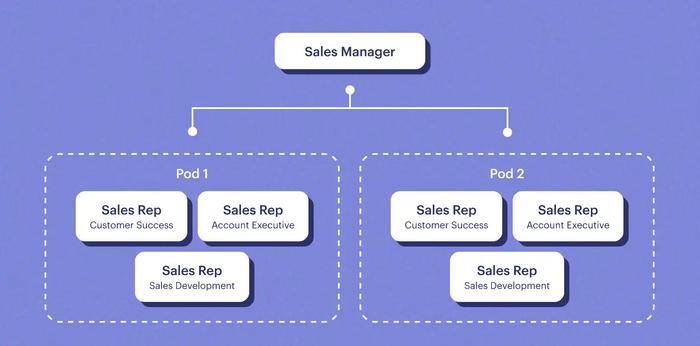Interest in why some sales teams consistently outperform? While the answers can be multiple, it often comes down to the sales methodology or approach applied in a particular team.
In a concept from 2010 – The Challenger Sale – Matthew Dixon and Brent Adamson introduced a novel sales approach which has since been approached by thousands of sales teams across the world.
Today, we’ll look closely at what Challenger sales model is so that you can explore the benefits and best practices yourself.
What is the Challenger Sales Model?
Matthew Dixon and Brent Adamson introduced the Challenger sales model in their The Challenger Sale book in 2010.
The Challenger model focuses on making customers think in new ways.
In this model, sales reps take on the role of a teacher. You're helping your prospects learn something totally new about the prospect's business. Things that make them go, "Huh, never thought of it that way." Sales reps are equipped to give them those "aha" moments that make them see their needs and how to solve them differently. Sales reps show customers insights they've never seen before – and this, naturally, shifts how they view their problems and solutions.
What are the three T's in The Challenger Sale?
The model outlines three main practices:
- Teaching: Enlightening prospects with new insights
- Tailoring: Customizing messages to resonate deeply with the unique concerns and contexts of each decision-maker
- Taking control: Confidently guiding the sales process – particularly around complex discussions like pricing and value proposition.
Challengers stand out because they're not afraid to nudge customers out of their comfort zones. They use this positive kind of pressure to question the usual ways of thinking, sparking action and decisions.
Challengers adapt to each situation with a unique approach and don't rely on a set script. Instead, they're always ready to switch things up. Sales reps listen closely to what the customer is saying and then tailor their message on the spot. This makes every customer conversation feel fresh and directly relevant to what the customer needs right now.

What are the 5 types of sellers in the challenger sales model?
In the Challenger sales model, sales reps are grouped into five distinct types based on their sales approach and interaction with clients. These types help identify different strategies and behaviors that salespeople naturally gravitate toward.
1. The hard worker
The hard worker shines in competitive and goal-oriented environments where effort and persistence directly correlate with success. Their relentless drive and willingness to put in extra hours make them excellent at volume-based selling.
However, they may struggle in scenarios that require deep industry research or strategic thinking. Their focus is more on activity and less on crafting disruptive insights.
2. The Lone Wolf
The lone wolf thrives in high-stakes situations where their intuition and willingness to bypass conventional processes can lead to big wins. They're particularly effective in fields where sales cycles are complex and non-linear.
Their weakness lies in team-based environments or where strict adherence to sales protocols is necessary. Lone Wolf's maverick style can lead to conflicts with structured sales strategies.
3. The relationship builder
The relationship builder excels in industries where long-term relationships and trust are paramount, such as high-ticket sales or B2B environments. Their strength is in creating customer loyalty and generating repeat business.
Relationship builders can see some struggles in transactional sales. Environments dominated by aggressive pricing and innovative product features are not their strong suit either.
4. The problem solver
The problem solver is most effective when clients require detailed, technical solutions. Industries like software, engineering, or healthcare often see problem solvers excel. Their main weakness lies in their decisiveness. Some situations require quick, determined action and a high level of adaptability which they often don't have.
5. The challenger
The challenger is particularly strong in complex sales environments where driving change or selling innovative solutions is required. They excel in situations where clients may not be aware they need a change.
Think B2B sales, disruptive industries, and high-value consultative sales. Challengers can transform hesitant prospects into committed customers.
Is The Challenger Sale book still relevant?
Yes, The Challenger Sale book remains highly relevant. Since its introduction, the Challenger selling model has proven to be a powerful technique in various sales environments – especially as buying behaviors and markets evolve.
Here's why it's still relevant:
- Sales got complex. That's where the challenger steps in. This method's core is teaching, customizing the pitch, and keeping the reins in your hands.
- Buyers know a lot. They've done their homework. But challengers? They bring the knowledge the buyers can't just google. A new perspective is what they aim to show.
- Markets are crowded. With everyone trying to sell something, standing out is tougher than ever. Challengers change the way buyers think. That's how you get noticed.
So, why is The Challenger Sale still relevant? It's simple: it covers today's sales challenges head-on, making them a go-to strategy for standing out, being heard, and making a difference in your customers' world.
[40% of top-performing sales pros}(https://www.gartner.com/smarterwithgartner/power-challenger-sales-model) embody the Challenger style. In complex sales scenarios, over half of the stellar performers align with the Challenger profile. Meanwhile, a mere 7% are relationship builders, ranking them at the bottom.
Challengers excel by teaching, tailoring, and taking the reins. In some cases, they transform the sales landscape.
The Challenger model shines in complex sales. In essence, it's digging deep and showing the cost of inaction.
But for simple sales cycles? Not so much. These don't let Challengers use their best moves, like offering new viewpoints or insights.
While top reps kill it with this method, average ones struggle. They find it hard to tailor messages or push for decisions. In short, the Challenger model rocks when sales are tough and the rep is sharp. Its success hinges on the sale's complexity and the rep's skill.
10 key steps to using Challenger model effectively
Using the Challenger sales model in practice means shifting your sales approach to focus on teaching, tailoring, and taking control. You can make it work for you by following these steps:
1. Teach, don't just sell
Let's break it down. You're not there to only push a product, right? You're there to share something new, something eye-opening. This approach flips the script. Instead of being seen as yet another salesperson, you become a trusted advisor.
So, how do you do it?
Well, first off, you need to discover your prospect's world. Get to know it inside out. Then, you come back with insights they haven't even thought about.
You start talking about their challenges in a way that lights up a bulb over their head.
When you teach customers, you build this solid trust. Why? Because it's clear you're not there just to make a quick buck. You're there to make a difference.
2. Tailor your message
What makes this point a turning point in so many cases?
Every decision-maker has their own set of worries, needs, and goals. Hitting the sweet spot means speaking directly to those pain points.
When you customize your pitch, you're telling your prospect, "I see you. I get what you're after." And now, you're offering a solution to their specific problem.
How do you win here? You need to get to know each decision-maker.
What makes them tick? What challenges are they facing? Then, use what you learn to shape your pitch and make it about them.
Show them that what you're offering fits perfectly into their world.
And here’s why it’s worth the effort: tailored messages make your prospects feel understood. They're more likely to listen, engage, and eventually buy. You're the one connecting the dots between their problem and your solution.

3. Take control of the sale
Challengers take control of the sale, almost like captaining a ship. You’re in charge, steering everything towards the destination and closing the deal.
But here’s the trick: you’ve got to do it in a way that doesn’t scare everyone on board.
Sales can get messy. Without a clear direction, you and your prospect might end up going in circles. Taking control means you keep the conversation on track. You make sure it's moving forward, heading towards a decision.
How do challengers pull it off? Start by setting the agenda early. Let your prospect know what to expect from your chat. Then, as you get into it, keep the focus on how your solution fits their needs. Sure, they might have concerns, especially about pricing.
That's your signal to guide them back, showing them the real value of what you're offering.
Taking control isn’t about being pushy. It’s about being confident. You know your thing. You know how it can help. So, you lead the conversation with that assurance, answering questions and addressing concerns before they even arise.
In the end, the main point is making sure your prospect feels they've made the right choice. Lead them through this process, and you help them make a decision that's good for the customer's business.
4. Challenge assumptions
Challenging assumptions is aboutgetting your prospects to pause, reconsider, and see things from a new angle.
Why go down this path? Simple. People get stuck in their ways. They think, "If it's not broken, why fix it?"
But here's the catch: just because something isn't broken doesn't mean it can't be better. Your job is to show them that 'better' is within reach.
How do you do it? By presenting facts, figures, and stories that make them go, "Hmm, I hadn't looked at it that way."
Challengers gently nudge them to a window they've never looked out of. They offer a unique perspective, one that shines a light on unexplored possibilities.
Do this without putting them on the defensive. It's a dance, you lead, but not too forcefully. You suggest, but don't insist. Your goal is to start a dialogue, one where they're open to exploring these new ideas with you.
And why does this matter? Because when you challenge assumptions successfully, you're selling a new way of thinking. You're positioning yourself not just as a vendor but as a visionary partner. That's a compelling proposition - much more than you think.
5. Focus on value, not price
When you sell avoid getting straight into pricing. Doing so means you’re missing out on the chance to show why your solution stands out.
Why make value your headline? Because anyone can cut prices. But not everyone can offer a solution that truly clicks with your prospect's needs. A challenger sales rep can.
When you emphasize value, you're talking about the bigger picture – how your product or service makes life easier, boosts the bottom line, or solves a complex problem in a way that no one else can.
How do you shift that focus? Bring the unique benefits to the table. Maybe it’s your exceptional customer service, the innovative features of your product, or how your service can save time and money in the long run.
These benefits can build a compelling case for your solution – beyond the price tag.
This line of action aligns with your prospect's long-term goals and challenges. Everyone is looking to get more for less, and showing how your solution delivers more – more efficiency, more savings, more growth – is what sets you apart.
6. Implement two-way communication
In two-way communication, you need to listen carefully, and then chime in with something that hits just right. In the Challenger sales model, this means flipping the script from a monologue to a real conversation where both sides get to talk – and listen.
Imagine being on the receiving end of a never-ending sales pitch. Not fun, right? People want to feel heard, especially when they're thinking about buying something. When you tune in and actively listen, you're building trust - and trust is what seals the deals in sales.
When it's your turn to speak, make it count. Challenger sales reps tailor their response to what their customer shared. Show that you're invested in what they're saying. It makes your solution feel like it was made entirely for them.
Two-way communication makes the whole sales process a team effort. You're in it together, finding the best solution.
7. Build credibility early on
Credibility is what everything else rests on.
In challenger sales, establishing yourself as knowledgeable and trustworthy from the get-go sets the tone for the entire conversation with your prospect.
Why start early? First impressions last. You kick things off by showing you know your stuff and you're here to help.
You show the prospect that you're a treasured resource.
How do you do it? Share your knowledge. But don't just rattle off facts. Instead, share valuable insights that matter to them, solve problems they're facing, or introduce them to new ideas that could benefit their business.
This shows you've done your homework and you genuinely care about their success, not simply closing a deal.
When you're seen as trustworthy and knowledgeable, everything gets easier. Decisions that might have taken weeks can be made in days. Questions that could have been doubts become conversations.
It's because at that point you become a trusted advisor to the customer.
8. Leverage constructive tension
You’re walking a tightrope. On one side, you've got your customer's comfort zone. On the other, the place where real growth happens.
Leveraging constructive tension is all about guiding your customer across that tightrope to new territories.
Why bother with tension? Because comfort zones are cozy, but nothing ever grows there. Your customers might be hesitant to leave what's familiar, but deep down, they know it's necessary for growth. Your role is to highlight this.
Show them what lies beyond their comfort zone – better solutions, improved efficiency, or maybe game-changing innovations.
How do you strike the right balance? It's all in how you present your ideas. You bring up challenges they might not have considered. You question the status quo in a way that's intriguing, not threatening. You make them think, "What if?"
Suddenly, they're moving along that tightrope, inching towards decisions they never thought they'd make.
This method requires finesse. You're not creating tension for the sake of it, but doing it to open their eyes to new possibilities.
You're helping them see that the risk of staying put outweighs the fear of stepping forward.
9. Implement the Challenger Sales Model in your team
Think about using the PAUSE framework to get your sales team, especially those into Challenger selling, to up their game. Sales leaders often use it as a step-by-step guide to becoming even better in those tough sales situations.
Why go with PAUSE? It chops up the sales training process into easy, doable steps. This way, coaches find it easier to lead their sales teams from point A to point B.
- First up, Preparation. This is where you lay the foundation. You figure out what each team member is good at and where they're stumbling. This lets sales managers tailor their coaching just right.
- Next is Affirming relationships. This step is all about building trust. You create a space where it's okay to give and take feedback seriously. When your team trusts you, they're more open to trying out new things you suggest.
- Then, dive into Understanding behavior. Get to the heart of how your team handles different sales situations. Understanding their why helps you guide them toward new ways of thinking and acting.
- Moving on to Specifying changes. Now, you've got a clear idea of what needs to change. It's time to map out how to get there. You've spotted the behaviors that need tweaking, and now you lay down a clear plan for making those shifts.
- Last, Embedding new behavior. Planning is one thing; doing is another. This part is particularly important for making those new tactics stick. You reinforce these strategies until they're part of what your team does.
Putting the PAUSE framework into play can change how your sales team performs. It's detailed but flexible, giving clear direction in the coaching journey and making sure every move is toward better performance.
10. Use a CRM like Capsule
If you're in sales, you're probably using a CRM, right?
Think of Capsule as your personal assistant, keeping all those crucial customer details in one neat package. From past chats to personal likes, it’s all there.
This means, that when it’s time to shake up a customer's perspective, you’ve got everything you need to make it personal and impactful.
Sales reps lean on Capsule because it transforms every interaction into a strategic play. With Capsule, you’re always a step ahead, making every conversation count towards that win.
Check Capsule CRM pricing here.
Key takeaways
- The Challenger Sales Model, introduced in 2010, revolutionizes traditional sales by emphasizing teaching over relationship building.
- Research reveals 53% of customer loyalty comes from the sales experience, underscoring the importance of the sales approach.
- Challenger reps, who teach, tailor, and take control, represent 40% of top sales performers, outperforming other sales types.
- The Challenger approach is especially effective in complex sales, with over 50% of all-star performers adopting this style.
- Only 7% of top sales performers primarily focus on relationship building, making it the least effective approach.
- Challengers excel by pushing customers to think differently, offering insights that challenge their preconceptions.
- The model identifies five sales rep profiles, with Challengers being the most successful due to their unique approach to sales.
- Sales got complex, and the Challenger model addresses this by providing strategies that resonate with informed buyers.
- Implementing the Challenger model involves mastering three T's: Teaching, Tailoring, and Taking control.
- The PAUSE framework offers a structured approach to embedding the Challenger method within sales teams, enhancing overall performance.
Conclusion
There is no doubt that the Challenger Sales Model has changed the game for many. It is particularly effective in complex sales environments.
It’s about ditching the old "play nice" strategy and getting on with tactics that teach, tailor, and take the helm. This strategy makes a big splash by encouraging buyers to rethink their needs and solutions. However, it’s important to remember its best fit: markets where challenging norms and pushing boundaries can truly make a difference.
So, while it’s not the secret sauce for every sale out there, in the right situations, it can be just the edge you need.
Take control of your sales with your Capsule free-trial.




